
醋酸尤利普里斯托
描述
尤利普里斯托是一种选择性孕激素受体调节剂,主要用于紧急避孕和子宫肌瘤的治疗。 它是一种 19-去甲孕酮的衍生物,在孕激素受体上表现出拮抗和部分激动作用 .
科学研究应用
作用机制
尤利普里斯托通过与孕激素受体结合发挥作用,在那里它既充当拮抗剂又充当部分激动剂。 这种结合通过阻止卵泡破裂来抑制排卵,并且还可能影响子宫内膜以阻止胚胎植入 . 分子靶点包括孕激素受体,以及在较小程度上,糖皮质激素受体 .
生化分析
Biochemical Properties
Ulipristal plays a significant role in biochemical reactions by interacting with various enzymes, proteins, and other biomolecules. It binds to the progesterone receptor, exhibiting both antagonistic and partial agonist activities. Additionally, ulipristal binds to the glucocorticoid receptor, although it has lower glucocorticoid activity compared to mifepristone . These interactions are crucial for its function as an emergency contraceptive and in the treatment of uterine fibroids.
Cellular Effects
Ulipristal affects various types of cells and cellular processes. In the treatment of uterine fibroids, ulipristal reduces the size of fibroids by inhibiting cell proliferation and inducing apoptosis . It also influences cell signaling pathways, gene expression, and cellular metabolism. For instance, ulipristal has been shown to delay or inhibit ovulation by affecting the endometrium, which may prevent embryo implantation .
Molecular Mechanism
The molecular mechanism of ulipristal involves its binding to the progesterone receptor, where it acts as both an antagonist and partial agonist . This binding prevents progestin from binding to the receptor, thereby inhibiting or delaying ovulation . Ulipristal also alters the normal endometrium, impairing implantation . Additionally, it inhibits the translocation of the glucocorticoid receptor to the nucleus, affecting gene expression .
Temporal Effects in Laboratory Settings
In laboratory settings, the effects of ulipristal change over time. Ulipristal is rapidly absorbed, with a peak plasma concentration occurring approximately one hour after ingestion . Its stability and degradation over time have been studied, showing that it can inhibit follicular rupture and induce early endometrial bleeding in a dose-dependent manner . Long-term effects on cellular function have also been observed, including changes in endometrial maturation and progesterone-dependent markers of implantation .
Dosage Effects in Animal Models
The effects of ulipristal vary with different dosages in animal models. A single post-ovulatory dose of ulipristal has been shown to impair post-fertilization events in mice, reducing the number of conceptuses and early implantation sites . High doses of ulipristal can cause histological and functional alterations in the uterine horns, affecting embryo-uterine interaction .
Metabolic Pathways
Ulipristal is metabolized primarily by the enzyme CYP3A4 and to a lesser extent by CYP1A2 . It is converted into mono-demethylated (active) and di-methylated (inactive) metabolites . These metabolic pathways are crucial for its pharmacokinetics and overall efficacy.
Transport and Distribution
Ulipristal is transported and distributed within cells and tissues, targeting the uterus, cervix, ovaries, and hypothalamus . It binds to plasma proteins with a high affinity, which influences its distribution and localization within the body . The transporters and binding proteins involved in its distribution play a significant role in its therapeutic effects.
Subcellular Localization
The subcellular localization of ulipristal involves its interaction with the glucocorticoid receptor, where it inhibits the receptor’s translocation to the nucleus . This inhibition affects the receptor’s activity and function, leading to changes in gene expression and cellular responses. Ulipristal’s targeting signals and post-translational modifications direct it to specific compartments or organelles, influencing its overall activity.
准备方法
合成路线和反应条件
尤利普里斯托的合成涉及多个步骤,从 19-去甲孕酮开始反应条件通常包括使用甲基锂或甲基格氏试剂等试剂进行加成反应,然后进行水解和结晶步骤以纯化最终产物 .
工业生产方法
尤利普里斯托的工业生产涉及优化合成路线以确保高产率和纯度。这包括控制水解条件,如酸度、温度和反应时间,以获得所需的产物。 最终产物用乙醇和异丙醇等溶剂进行纯化 .
化学反应分析
反应类型
尤利普里斯托经历各种化学反应,包括:
氧化: 尤利普里斯托可以被氧化形成不同的代谢物。
还原: 还原反应可以改变分子中存在的酮基。
取代: 取代反应可以在二甲氨基或乙酰氧基处发生。
常用试剂和条件
这些反应中常用的试剂包括高锰酸钾等氧化剂和硼氢化钠等还原剂。 这些反应通常在受控温度和 pH 条件下进行,以确保所需产物的形成 .
形成的主要产物
相似化合物的比较
类似化合物
米非司酮: 另一种用于药物流产和紧急避孕的孕激素受体拮抗剂。
左炔诺孕酮: 一种合成的孕激素,用于紧急避孕和激素避孕药。
尤利普里斯托的独特性
尤利普里斯托在孕激素受体上既作为拮抗剂又作为部分激动剂的双重活性是其独特的,这使其与米非司酮和左炔诺孕酮等其他化合物相比具有独特的疗效和副作用特征 .
属性
IUPAC Name |
(8S,11R,13S,14S,17R)-17-acetyl-11-[4-(dimethylamino)phenyl]-17-hydroxy-13-methyl-1,2,6,7,8,11,12,14,15,16-decahydrocyclopenta[a]phenanthren-3-one | |
|---|---|---|
| Source | PubChem | |
| URL | https://pubchem.ncbi.nlm.nih.gov | |
| Description | Data deposited in or computed by PubChem | |
InChI |
InChI=1S/C28H35NO3/c1-17(30)28(32)14-13-25-23-11-7-19-15-21(31)10-12-22(19)26(23)24(16-27(25,28)2)18-5-8-20(9-6-18)29(3)4/h5-6,8-9,15,23-25,32H,7,10-14,16H2,1-4H3/t23-,24+,25-,27-,28-/m0/s1 | |
| Source | PubChem | |
| URL | https://pubchem.ncbi.nlm.nih.gov | |
| Description | Data deposited in or computed by PubChem | |
InChI Key |
HKDLNTKNLJPAIY-WKWWZUSTSA-N | |
| Source | PubChem | |
| URL | https://pubchem.ncbi.nlm.nih.gov | |
| Description | Data deposited in or computed by PubChem | |
Canonical SMILES |
CC(=O)C1(CCC2C1(CC(C3=C4CCC(=O)C=C4CCC23)C5=CC=C(C=C5)N(C)C)C)O | |
| Source | PubChem | |
| URL | https://pubchem.ncbi.nlm.nih.gov | |
| Description | Data deposited in or computed by PubChem | |
Isomeric SMILES |
CC(=O)[C@]1(CC[C@@H]2[C@@]1(C[C@@H](C3=C4CCC(=O)C=C4CC[C@@H]23)C5=CC=C(C=C5)N(C)C)C)O | |
| Source | PubChem | |
| URL | https://pubchem.ncbi.nlm.nih.gov | |
| Description | Data deposited in or computed by PubChem | |
Molecular Formula |
C28H35NO3 | |
| Source | PubChem | |
| URL | https://pubchem.ncbi.nlm.nih.gov | |
| Description | Data deposited in or computed by PubChem | |
DSSTOX Substance ID |
DTXSID501025842 | |
| Record name | Ulipristal | |
| Source | EPA DSSTox | |
| URL | https://comptox.epa.gov/dashboard/DTXSID501025842 | |
| Description | DSSTox provides a high quality public chemistry resource for supporting improved predictive toxicology. | |
Molecular Weight |
433.6 g/mol | |
| Source | PubChem | |
| URL | https://pubchem.ncbi.nlm.nih.gov | |
| Description | Data deposited in or computed by PubChem | |
Mechanism of Action |
The exact mechanism of action of ulipristal has been heavily debated. On one hand, the majority of official prescribing information labels, monographs, and prior research studies for ulipristal indicated as an emergency contraceptive suggest that its primary mechanism of action revolves around inhibiting or delaying ovulation by suppressing surges in LH that result in the postponement of follicular rupture. Conversely, some of the latest investigations pertaining to ulipristal's mechanism of action as an emergency contraceptive propose that it principally elicits its action by preventing embryo implantation, as opposed to preventing ovulation. Although previous investigations have shown that ulipristal essentially has the ability to prevent ovulation equivalent to placebo (ie. null effect or ability) when administered during LH peaks one to two days before ovulation, the agent still demonstrates a stable and consistently high contraceptive effect of approximately >=80% when used at this time. Subsequently, current studies attempt to investigate how ulipristal could elicit emergency contraception via ovulation prevention under circumstances where ovulation had already clearly been observed. Endometrial biopsy samples studied from such circumstances in such investigations subsequently show that the administered ulipristal causes endometrial tissue to become inhospitable and unsuitable for embryo implantation where a variety of genes characteristic of receptive, pro-gestational endometrium are downregulated. Nevertheless, most if not all proposed mechanisms commonly agree that ulipristal ultimately demonstrates its pharmacological effects by binding to human progesterone receptors and prevents natural, endogenous progesterone from occupying such receptors. Regardless, however, considering current and on-going research into ulipristal's ability to prevent embryo implantation, the notion that the medication can elicit post-fertilization effects potentially raises alerts and/or ethical debates over the use of ulipristal owing to potential abortifacient activity, which is considered to be on par or equipotent to that of mifepristone. Attention should be drawn to the fact that some prescribing information, however, such as the US FDA label for ulipristal indicated for emergency contraception, has included new supplementary commentary since 2018 that directly warns about ulipristal not being indicated for termination of existing pregnancies and suggesting that ulipristal use may confer alterations to the endometrium that may affect implantation and contribute to efficacy. In the treatment of fibroids, ulipristal has been shown to exert direct actions on fibroids reducing their size through inhibition of cell proliferation and induction of apoptosis. | |
| Record name | Ulipristal | |
| Source | DrugBank | |
| URL | https://www.drugbank.ca/drugs/DB08867 | |
| Description | The DrugBank database is a unique bioinformatics and cheminformatics resource that combines detailed drug (i.e. chemical, pharmacological and pharmaceutical) data with comprehensive drug target (i.e. sequence, structure, and pathway) information. | |
| Explanation | Creative Common's Attribution-NonCommercial 4.0 International License (http://creativecommons.org/licenses/by-nc/4.0/legalcode) | |
CAS No. |
159811-51-5 | |
| Record name | Ulipristal [USAN:INN:BAN] | |
| Source | ChemIDplus | |
| URL | https://pubchem.ncbi.nlm.nih.gov/substance/?source=chemidplus&sourceid=0159811515 | |
| Description | ChemIDplus is a free, web search system that provides access to the structure and nomenclature authority files used for the identification of chemical substances cited in National Library of Medicine (NLM) databases, including the TOXNET system. | |
| Record name | Ulipristal | |
| Source | DrugBank | |
| URL | https://www.drugbank.ca/drugs/DB08867 | |
| Description | The DrugBank database is a unique bioinformatics and cheminformatics resource that combines detailed drug (i.e. chemical, pharmacological and pharmaceutical) data with comprehensive drug target (i.e. sequence, structure, and pathway) information. | |
| Explanation | Creative Common's Attribution-NonCommercial 4.0 International License (http://creativecommons.org/licenses/by-nc/4.0/legalcode) | |
| Record name | Ulipristal | |
| Source | EPA DSSTox | |
| URL | https://comptox.epa.gov/dashboard/DTXSID501025842 | |
| Description | DSSTox provides a high quality public chemistry resource for supporting improved predictive toxicology. | |
| Record name | (8S,11R,13S,14S,17R)-17-acetyl-11-[4-(dimethylamino)phenyl]-17-hydroxy-13-methyl-1,2,6,7,8,11,12,14,15,16-decahydrocyclopenta[a]phenanthren-3-one | |
| Source | European Chemicals Agency (ECHA) | |
| URL | https://echa.europa.eu/information-on-chemicals | |
| Description | The European Chemicals Agency (ECHA) is an agency of the European Union which is the driving force among regulatory authorities in implementing the EU's groundbreaking chemicals legislation for the benefit of human health and the environment as well as for innovation and competitiveness. | |
| Explanation | Use of the information, documents and data from the ECHA website is subject to the terms and conditions of this Legal Notice, and subject to other binding limitations provided for under applicable law, the information, documents and data made available on the ECHA website may be reproduced, distributed and/or used, totally or in part, for non-commercial purposes provided that ECHA is acknowledged as the source: "Source: European Chemicals Agency, http://echa.europa.eu/". Such acknowledgement must be included in each copy of the material. ECHA permits and encourages organisations and individuals to create links to the ECHA website under the following cumulative conditions: Links can only be made to webpages that provide a link to the Legal Notice page. | |
| Record name | ULIPRISTAL | |
| Source | FDA Global Substance Registration System (GSRS) | |
| URL | https://gsrs.ncats.nih.gov/ginas/app/beta/substances/6J5J15Q2X8 | |
| Description | The FDA Global Substance Registration System (GSRS) enables the efficient and accurate exchange of information on what substances are in regulated products. Instead of relying on names, which vary across regulatory domains, countries, and regions, the GSRS knowledge base makes it possible for substances to be defined by standardized, scientific descriptions. | |
| Explanation | Unless otherwise noted, the contents of the FDA website (www.fda.gov), both text and graphics, are not copyrighted. They are in the public domain and may be republished, reprinted and otherwise used freely by anyone without the need to obtain permission from FDA. Credit to the U.S. Food and Drug Administration as the source is appreciated but not required. | |
Retrosynthesis Analysis
AI-Powered Synthesis Planning: Our tool employs the Template_relevance Pistachio, Template_relevance Bkms_metabolic, Template_relevance Pistachio_ringbreaker, Template_relevance Reaxys, Template_relevance Reaxys_biocatalysis model, leveraging a vast database of chemical reactions to predict feasible synthetic routes.
One-Step Synthesis Focus: Specifically designed for one-step synthesis, it provides concise and direct routes for your target compounds, streamlining the synthesis process.
Accurate Predictions: Utilizing the extensive PISTACHIO, BKMS_METABOLIC, PISTACHIO_RINGBREAKER, REAXYS, REAXYS_BIOCATALYSIS database, our tool offers high-accuracy predictions, reflecting the latest in chemical research and data.
Strategy Settings
| Precursor scoring | Relevance Heuristic |
|---|---|
| Min. plausibility | 0.01 |
| Model | Template_relevance |
| Template Set | Pistachio/Bkms_metabolic/Pistachio_ringbreaker/Reaxys/Reaxys_biocatalysis |
| Top-N result to add to graph | 6 |
Feasible Synthetic Routes
体外研究产品的免责声明和信息
请注意,BenchChem 上展示的所有文章和产品信息仅供信息参考。 BenchChem 上可购买的产品专为体外研究设计,这些研究在生物体外进行。体外研究,源自拉丁语 "in glass",涉及在受控实验室环境中使用细胞或组织进行的实验。重要的是要注意,这些产品没有被归类为药物或药品,他们没有得到 FDA 的批准,用于预防、治疗或治愈任何医疗状况、疾病或疾病。我们必须强调,将这些产品以任何形式引入人类或动物的身体都是法律严格禁止的。遵守这些指南对确保研究和实验的法律和道德标准的符合性至关重要。



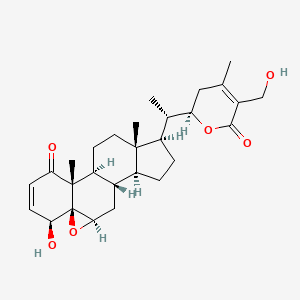
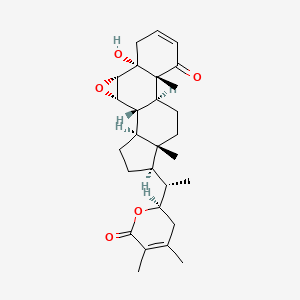
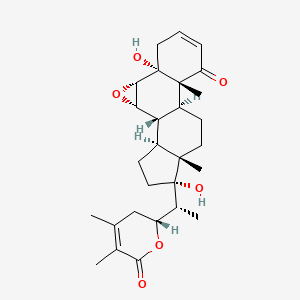
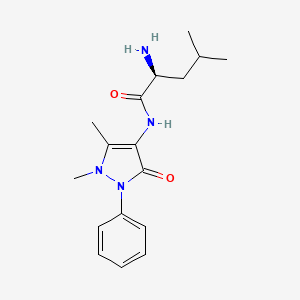
![5-(2,2-Diphenylacetyl)-4-[(4-methoxy-3-methylphenyl)methyl]-1,4,6,7-tetrahydroimidazo[4,5-c]pyridine-6-carboxylic acid](/img/structure/B1683315.png)



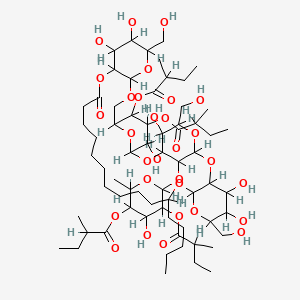

![(7S,9S)-9-acetyl-7-[(2R,4S,5S,6S)-4-[[4-[[[(2S,3S,4S,6R)-6-[[(1S,3S)-3-acetyl-3,5,12-trihydroxy-10-methoxy-6,11-dioxo-2,4-dihydro-1H-tetracen-1-yl]oxy]-3-hydroxy-2-methyloxan-4-yl]amino]methyl]phenyl]methylamino]-5-hydroxy-6-methyloxan-2-yl]oxy-6,9,11-tri](/img/structure/B1683324.png)


